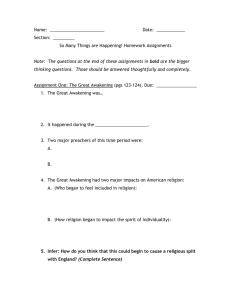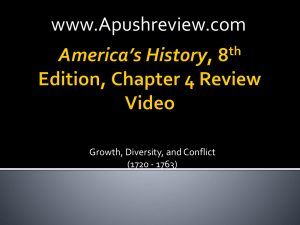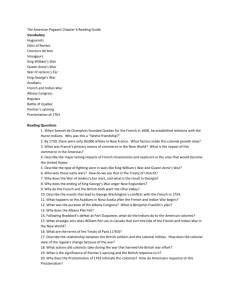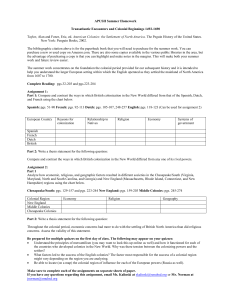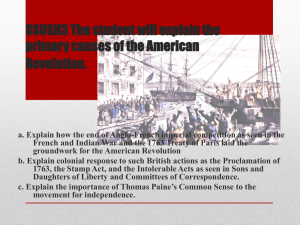Name
advertisement
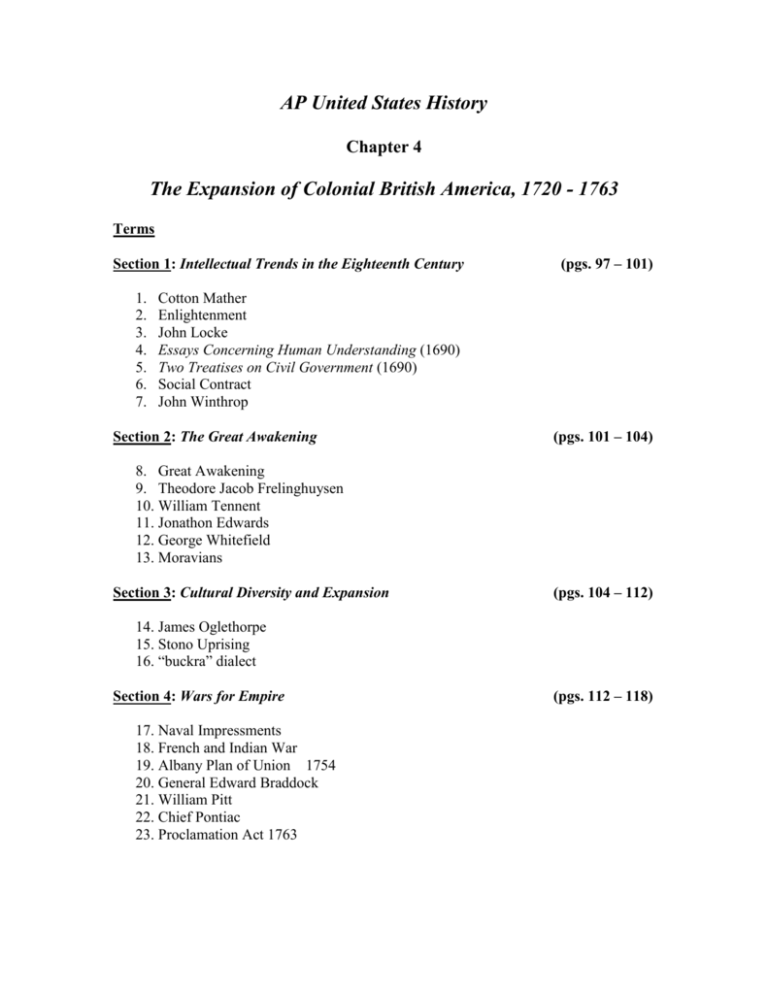
AP United States History Chapter 4 The Expansion of Colonial British America, 1720 - 1763 Terms Section 1: Intellectual Trends in the Eighteenth Century 1. 2. 3. 4. 5. 6. 7. (pgs. 97 – 101) Cotton Mather Enlightenment John Locke Essays Concerning Human Understanding (1690) Two Treatises on Civil Government (1690) Social Contract John Winthrop Section 2: The Great Awakening (pgs. 101 – 104) 8. Great Awakening 9. Theodore Jacob Frelinghuysen 10. William Tennent 11. Jonathon Edwards 12. George Whitefield 13. Moravians Section 3: Cultural Diversity and Expansion (pgs. 104 – 112) 14. James Oglethorpe 15. Stono Uprising 16. “buckra” dialect Section 4: Wars for Empire 17. Naval Impressments 18. French and Indian War 19. Albany Plan of Union 1754 20. General Edward Braddock 21. William Pitt 22. Chief Pontiac 23. Proclamation Act 1763 (pgs. 112 – 118) Section 5: The British Provinces in 1763 24. Mercantilism 25. Navigation Acts 26. Enumerated articles 27. Molasses Act 1733 28. Paxton Boys Rebellion (pgs. 118 – 123) AP United States History Chapter 4 The Expansion of Colonial British America, 1720 - 1763 Objectives Section 1: Intellectual Trends in the Eighteenth Century (pgs. 97 – 101) 1. Explain who Cotton Mather was and the irony behind his work in inoculations. 2. Describe the basic inclination of the Enlightenment Period and the three educational disciplines it affected. 3. Regarding Locke’s theories and writings, explain the following: a. Two publication titles c. Natural Rights b. Natural laws d. Social Contract 4. What 3 factors seemed to impact one’s education during the colonial period? 5. List 3 early colonial colleges established by 1750. 6. List 5 occupations for which colonial colleges prepared students. Section 2: The Great Awakening (pgs. 101 – 104) 7. What was the Great Awakening? 8. Describe Christian rationalism. 9. List the 2 areas of American society that was threatened by the Great Awakening. 10. Describe the differences of beliefs and worship styles of “Old Lights” and “New Lights” religions and why this caused social controversy. 11. Describe the input of the following theologians during the Great Awakening: a. Theodore Jacob Frelinghuysen c. Jonathon Edwards b. William Tennent d. George Whitefield 12. List 6 major colleges established in the colonies as a result of the Great Awakening. Section 3: Cultural Diversity and Expansion (pgs. 104 – 112) 13. Regarding German and Scots-Irish immigration: a. Period of immigration b. Leading colony of settlement c. 7 major religions brought with them d. 2 reasons why they were relatively not involved in politics 14. Regarding the settlement of Georgia: a. 2 motivating reasons for Oglethorpe to settle the region b. 3 policies governing settlement c. 3 components of Oglethorpe’s policy toward Native Americans d. 4 reasons why settlers avoided Georgia 15. Regarding African culture in America: a. Number of imports between 1720 – 1776 b. Region of Africa from which imported c. Percentage of 1750 colonial America population d. 5 components of African culture they could influence e. Describe the origins of the “gullah” dialect 16. Explain the broader result of the Stono Slave Rebellion 17. Describe the difference between “salt water” and “Country born” slaves 18. Describe “settlement Indians” Section 4: Wars for Empire (pgs. 112 – 118) 19. Describe the 2 forces involved in the War of Jenkin’s Ear and the issue causing the conflict. 20. Describe what England received after the Treaty of Utrecht regarding the Atlantic Slave trade 21. Describe the 2 forces involved in King George’s War and the issue causing the conflict in the America colonies. 22. Describe the 2 forces involved in the French and Indian War here in colonial America, their perspective allies, and the 2 leading issues causing conflict. 23. Regarding the Albany Congress: a. Who did the Iroquois remain loyal to b. Who proposed the Albany Plan of Union c. 3 governing functions proposed for each colony to have 24. List the 3 leading Indian tribes whose alliance with France, caused frontier attacks on Americans. 25. What were naval impressments? 26. List the role of the following British political/military leaders during the French and Indian War: a. William Pitt c. Jeffrey Amherst b. General Edward Braddock d. James Wolfe 27. Describe the effect the French and Indian War had between American and British relations. 28. Within the Treaty of Paris 1763 who acquired the following regions: a. Canada b. Lands east of the Mississippi River c. Florida 29. Describe Chief Pontiac’s efforts against whites in the Ohio River Valley. 30. List 4 negative effects the British victory over France had on Native Americans of the Ohio River Valley. 31. List the 3 components of Neolin’s cultural message to the Delaware and Shawnee Indians 32. Explain the failure of the Proclamation Act of 1763 Section 5: The British Provinces in 1763 (pgs. 118 – 123) 33. Explain how by 1763 Americans came to view themselves as equals with the British citizens. 34. Regarding British mercantilism, explain the following: a. The role of the colonies b. What were Enumerated articles c. How did Britain benefitted from the arrangement. 35. Describe the intention of the following Navigation Acts: a. Woolen Act 1699 b. Hat Act 1732 c. Molasses Act 1733 d. Iron Act 1750 36. Describe the “consumer revolution” and how it affected British-American relationships 37. Describe the underlying issue that led to the Paxton Boys Rebellion in 1763. 38. List 6 changes in British politics that shifted power from the Crown to Parliament following the Glorious Revolution of 1688. 39. Describe the difference between the voting rights in Britain and America and how that affected the concept of representative government in America 40. List 3 requirements for voting in colonial America 41. Describe the differences between direct and virtual representation. 42. List 5 powers gradually assumed by colonial legislative bodies in the early 1700’s.
